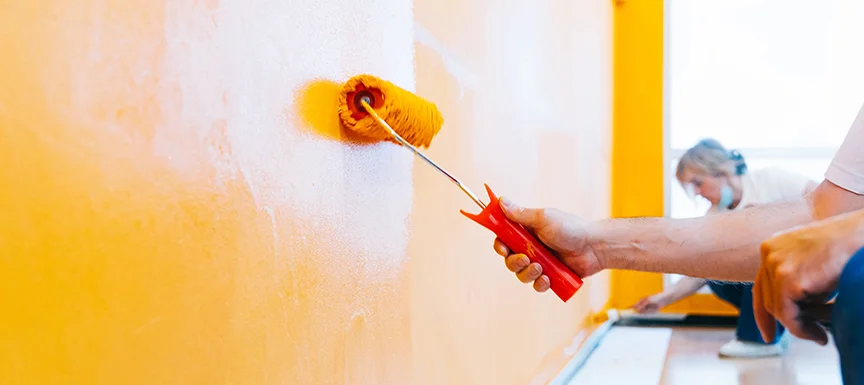Exploring the Different Kinds Of Paint: A Guide for every single Job
Exploring the numerous types of paint is important for accomplishing the desired result in any kind of job. From water-based options that offer benefit to oil-based paints recognized for their toughness, each choice has its qualities. Specialized paints can include unique structures or finishes, while eco-friendly choices satisfy those looking for sustainability. Recognizing these distinctions can greatly affect the success of a painting venture. What factors should one think about when making the appropriate selection?
Understanding Paint Kinds: Oil-Based vs. water-based
Paint types can markedly impact a job's end result, and comprehending the distinctions between water-based and oil-based paints is important for notified decision-making. Water-based paints, frequently referred to as latex paints, are composed of water as the key solvent. They dry rapidly, discharge fewer unpredictable natural compounds (VOCs), and are simple to clean up with soap and water. This makes them a popular choice for interior applications and atmospheres where air quality is a problem.
On the other hand, oil-based paints make use of natural solvents, offering a sturdy, glossy finish perfect for surfaces subjected to tear and wear, such as trim and cupboards. They take longer to completely dry, require mineral spirits for cleaning, and have a stronger odor. paint store corpus christi tx. Selecting between these 2 kinds depends upon the details needs of the project, taking into consideration aspects such as preferred surface, application environment, and simplicity of maintenance. Each kind has distinct advantages and restrictions, assisting the option process
The Finish Matters: Selecting Between Matte, Satin, and Gloss
When selecting a paint surface, the option in between matte and shiny options greatly influences both visual appeals and capability. Matte surfaces use a subtle, non-reflective look that can hide surface imperfections, while shiny surfaces offer toughness and ease of cleansing. Understanding the benefits and factors to consider of each can assist in making a notified decision for any type of painting project.
Matte End Up Benefits
Lots of homeowners question the benefits of various coatings, matte paint offers unique benefits that make it a prominent choice for both indoor and outside applications. Among the primary benefits of matte coating is its capacity to hide surface imperfections, creating a smoother appearance on walls. This quality is specifically useful in older homes or areas with irregular surfaces. Additionally, matte paint soaks up light instead of mirroring it, which can boost the aesthetic of a room by providing a much more innovative and soft appearance. Matte surfaces are typically easier to touch up than glossier options, as they can mix much more perfectly when used over existing paint. Overall, matte paint is an excellent selection for those looking for a fine-tuned and sophisticated finish.
Glossy End Up Considerations
A shiny coating can significantly alter the assumption of an area, using a reflective and sleek top quality that boosts both shade vibrancy and light within a room. This surface is typically favored for high-traffic areas and surface areas like kitchens and restrooms, where durability and convenience of cleansing are essential. Nevertheless, its reflective nature can highlight blemishes on walls, making appropriate surface area preparation crucial. Glossy paints additionally tend to reveal spots and finger prints quicker, requiring routine maintenance. In addition, lighting plays a significant role; in brilliant atmospheres, a glossy surface may develop glow, impacting the overall visual. As a result, cautious factor to consider of the certain application and setting is very important when choosing a shiny coating for any task.
Specialized Paints: When to Use Textured or Chalk Paint
Specialty paints, such as distinctive and chalk paint, offer unique aesthetic and practical benefits that can enhance numerous surface areas. Distinctive paint is ideal for creating deepness and measurement on walls, concealing imperfections while adding a three-dimensional feeling. It is particularly beneficial in high-traffic areas where resilience and visual interest are crucial.

Both kinds of specialty paints can change areas, but selecting the ideal one depends on the wanted result and surface area demands. Distinctive paint may suit larger areas, while chalk paint can rejuvenate smaller items, showcasing creative thinking and individual design in any job.
Exterior Paints: Protecting Your Surfaces From the Aspects
Outdoor paints are vital for guarding surfaces versus numerous weather. Recognizing their weather resistance attributes, correct surface area preparation demands, and effective application strategies can significantly boost resilience and performance. This section will lay out key considerations for choose and making use of outdoor paints properly.
Climate Resistance Includes
Weather condition resistance is a necessary function of exterior paints, as it identifies exactly how well surface areas can hold up against the extreme elements of nature. High-quality outside paints are created to withstand damage from UV rays, wetness, and temperature level changes. UV resistance assurances shades remain vivid in time, preventing fading and discoloration. Wetness resistance shields against mold and mildew and mold, which can endanger the stability of surface areas. Furthermore, paints with exceptional temperature level resistance can get and broaden without breaking, preserving their protective qualities. When choosing exterior paints, it is important to think about these climate resistance attributes, as they add to the durability and toughness of colored surface areas, ensuring they stay visually pleasing and useful regardless of exposure to the components.
Surface Prep Work Requirements
Proper surface preparation is a basic action in accomplishing the most effective results with exterior paints. To ensure perfect bond and toughness, surface areas have to be extensively cleansed, getting rid of dirt, mildew, and oil. This can be accomplished utilizing a pressure washing machine or a scrub brush with a suitable cleansing option. Once cleaned up, surfaces must be inspected for any type of peeling or flaking paint, which have to be scuffed away to create a smooth structure. Fixing any type of splits or holes is additionally important, as these can allow dampness infiltration. In addition, fining sand rough areas promotes much better paint bond. Using a guide suited for outdoor usage can enhance the paint's efficiency, assuring a resilient finish that holds up against the components. Correct prep work is crucial to a successful outside painting job.
Application Techniques Tips
While using outside paints, it is important to use effective methods that guarantee surfaces are well-protected versus the aspects. Choose the website right day for paint; low humidity and moderate temperatures enhance adhesion and drying. Prepping the surface area thoroughly-- cleaning, sanding, and priming-- ensures much better paint adhesion and durability. Utilizing top quality brushes or rollers can give a smoother finish, while spray paint might cover huge areas effectively. Applying paint in thin, even coats avoids drips and runs. It is recommended to comply with manufacturer directions relating to drying out times in between coats. Ultimately, confirm appropriate ventilation during application to promote drying and lessen direct exposure to fumes. These techniques considerably boost the long life and effectiveness of outdoor paint.
Eco-Friendly Options: Low-VOC and Zero-VOC Paints
As consumers end up being progressively knowledgeable about the ecological effect of their choices, low-VOC and zero-VOC paints have actually emerged as prominent alternatives. These paints are developed to consist of fewer unstable natural compounds (VOCs), which are chemicals that can evaporate right into the air and add to air contamination and health and wellness troubles. Low-VOC paints generally include a limited quantity of VOCs, while zero-VOC paints have minimal degrees, making them more secure for both outside and interior usage.
The advantages of utilizing zero-voc and low-voc paints prolong past environmental factors to consider; they additionally enhance interior air high quality, minimizing the danger of sensitive reactions and breathing problems. Lots of producers currently provide a range of shades and coatings in environmentally friendly options, making it less complicated for customers to locate suitable items for their jobs. By going with these paints, people can add to a healthier atmosphere while still attaining the aesthetic they prefer in their spaces.
Devices and Strategies for a Remarkable Application
Achieving a flawless paint application requires the right tools and strategies, which can greatly enhance the final outcome. Choosing the appropriate brush or roller is necessary; brushes function well for sides and intricate areas, while rollers cover larger surface areas successfully. Making use of high-grade products guarantees far better paint distribution and minimizes streaks. For optimal outcomes, surface prep work is essential. This includes cleansing, fining sand, and priming surface areas to advertise adhesion.
Technique likewise plays a significant role. The "W" technique with a roller aids to equally distribute paint, while long, smooth strokes with a brush stop visible lines. Operating in sections enables better control and mixing. Additionally, using thin coats is more suitable to thick layers, reducing the danger of drips and irregular appearances. Keeping a damp edge throughout application assists achieve smooth adjustments between areas. By incorporating these devices and methods, one can accomplish a specialist and sleek finish.
Tips for Preserving and Taking Care Of Your Painted Surfaces
Correct upkeep and treatment of painted surfaces can significantly prolong their life-span and maintain their look. Routine cleaning is essential; utilizing a soft towel or sponge with light soap and water can eliminate dust and dust without harming the paint. It is suggested to stay clear of rough cleansers or rubbing pads, as these can scratch the surface. Additionally, applying a fresh layer of paint every couple of years can invigorate the color and safeguard against wear.
For outdoor surface areas, evaluating for signs of peeling off or fading regularly is necessary. Promptly attending to any type of concerns avoids more damage. In areas vulnerable to moisture, such as restrooms, using mold-resistant paint and making sure correct air flow can help maintain the stability of the paint. Utilizing safety finishes can protect against UV rays and discolorations, ensuring that painted surface areas remain enticing and dynamic for years to come, inevitably improving the total aesthetic of the area.
Visual Frequently Asked Inquiries
Can I Mix Different Kind Of Paint With Each Other?
Blending different types of paint is typically not recommended, as it can lead to issues like inadequate attachment, irregular structure, or unexpected chemical reactions. It's ideal to make use of compatible paints for perfect results and resilience.

Just how Do I Correctly Shop Surplus Paint?
To properly keep remaining paint, secure the container tightly, label it with the day and shade, and maintain it in an awesome, completely dry area far from direct sunlight and extreme temperature levels for ideal preservation.
What Is the most effective Method to Take Care Of Unused Paint?
The most effective method to take care of extra paint is to check regional guidelines, as several locations have actually marked hazardous waste facilities. Alternatively, think about contributing functional paint to neighborhood organizations or institutions for their jobs.
How Can I Tell if Paint Is Still Excellent to Make Use Of?
To establish if paint is still excellent, analyze its color, scent, and uniformity. If it appears apart, has an undesirable odor, or shows substantial adjustments in structure, it's likely no much longer useful.
Are There Age Restrictions for Buying Paint Products?
In many areas, there are no certain age limitations for purchasing paint items. Nevertheless, some stores might need customers to be a minimum of 18 years old, particularly for items including solvents or hazardous products.
Paint kinds can considerably affect a task's result, and understanding the differences between water-based and oil-based paints is essential for informed decision-making. Water-based paints, typically referred to as latex paints, are composed of water as the key solvent. In contrast, oil-based paints use organic solvents, giving a long lasting, glossy surface perfect for surfaces subjected to tear and use, such as trim and closets. Specialty paints, such as textured and chalk paint, deal unique visual and sensible benefits that can improve numerous surfaces. In areas vulnerable to moisture, such as shower rooms, making use of mold-resistant paint and guaranteeing appropriate air flow can help preserve the stability of the paint.